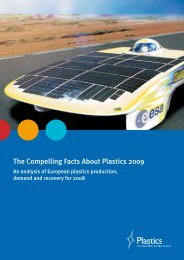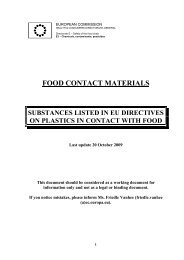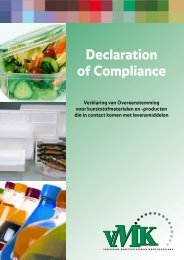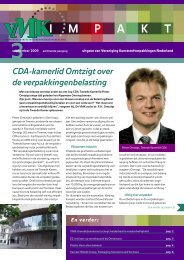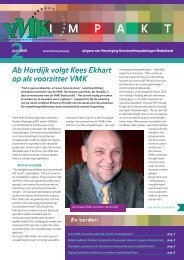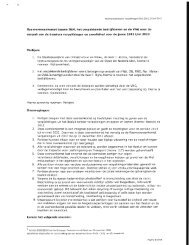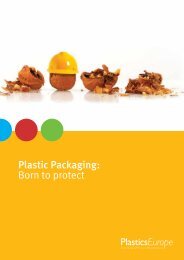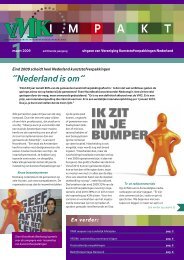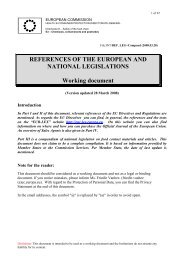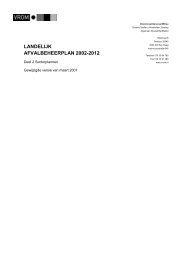Create successful ePaper yourself
Turn your PDF publications into a flip-book with our unique Google optimized e-Paper software.
Into the Future<br />
with Plastic.<br />
On the Sustainability of<br />
Plastic <strong>Packaging</strong>s.
Contents<br />
Preserving. Environmentally <strong>Friendly</strong> <strong>Packaging</strong>. 4<br />
Protecting. <strong>Consumer</strong> <strong>Friendly</strong> <strong>Packaging</strong>. 12<br />
Saving. Economical <strong>Packaging</strong>. 18<br />
<strong>Packaging</strong> of the Future. 22<br />
Imprint 23
Sustainable <strong>Packaging</strong>.<br />
<strong>Packaging</strong>s are increasingly assessed from<br />
sustainability aspects. But it is often overlooked<br />
that the principle of sustainability is not just<br />
limited to ecological factors, but takes equal<br />
account of economic and social aspects. Sustainable<br />
packaging therefore means economical,<br />
consumer friendly and environmentally<br />
friendly packaging. Plastic packagings meet<br />
these requirements in a very special way. The<br />
brochure „Into the Future with Plastic“ illustrates<br />
this using examples.<br />
3
Preserving.<br />
Environmentally <strong>Friendly</strong> <strong>Packaging</strong>.<br />
4
„Plastic packagings preserve more resources<br />
then they consume themselves.“<br />
5
6<br />
Enjoying Sustainably.<br />
Fresh stays fresh...<br />
Plastic packagings extend the shelf life of<br />
foods. Fruit stays fresh, cooked meats remain<br />
tasty and cheese keeps its flavour. Everything<br />
is very different without packaging. Many foodstuffs<br />
quickly lose their freshness and quality.<br />
For example, cheese without packaging<br />
after 3 days with packaging<br />
Cheese slices packaged - unpackaged<br />
very quickly loses its appearance and taste.<br />
The result: it ends up in the bin.<br />
High-tech barrier films protect against the<br />
loss of flavour, drying out and spoiling. Windows<br />
make it easy to see: the product is fresh.<br />
after 3 days without packaging
...and for ever longer.<br />
<strong>Packaging</strong>s are constantly being further developed. This<br />
means that foodstuffs have longer shelf lives. New materials<br />
have improved resealing. Special multi-layered films allow<br />
CO to escape, while preventing oxygen from penetrat-<br />
2<br />
ing. The packaging thus slows down the maturation<br />
process, e.g. of cheese, so that it keeps for longer.<br />
And, for these special properties, plastic packagings<br />
need less and less energy in production -<br />
as the example of the total energy used in cheese<br />
shows.<br />
Source: Incpen<br />
79% cheese<br />
manufacture<br />
2% cheese packaging<br />
Only 2 per cent for the cheese packaging.<br />
Modern plastic cans made of multi-layered films<br />
with an integrated double barrier can already keep<br />
various foodstuffs fresh for up to two years.<br />
3% transport packaging<br />
3% transport from the factory<br />
3% retail<br />
2% shopping trip<br />
8% storage in the fridge<br />
7
8<br />
Product Protection is<br />
Climate Protection.<br />
Odour- and taste-neutral, hygienic,<br />
insulating and lightweight:<br />
insulating boxes made of polystyrene<br />
Well packaged. Good for the climate.<br />
Unpackaged or incorrectly packaged - many<br />
foodstuffs spoil because they are not in the<br />
right packaging. In European households<br />
alone more than 70 million tonnes of food<br />
are thrown away every year. For example, the<br />
production of 1 kg of beef causes the release of<br />
13 kg of CO . If the beef goes off because it has<br />
2<br />
Plastic packagings prevent CO 2 .<br />
1 kg beef 13.3 kg CO 2<br />
1 kg coffee 8.5 kg CO 2<br />
1 kg French fries 5.7 kg CO 2<br />
1 kg soft cheese 1.95 kg CO 2<br />
1 kg pasta 0.92 kg CO 2<br />
Source: IK<br />
not been adequately protected, these 13 kg of<br />
CO have burdened the climate unnecessarily.<br />
2<br />
And the same amount is caused again for the<br />
production of the replacement. Plastic packagings<br />
guarantee a longer shelf life. That is<br />
good for the climate.<br />
1.5 l PET bottle 0.085 kg CO 2<br />
0.5 l PP meat tray 0.084 kg CO 2<br />
0.5 l PP yoghurt pot 0.073 kg CO 2<br />
0.5 l PS tray 0.065 kg CO 2<br />
1 m2 LDPE film 12μ 0.049 kg CO 2
The CO 2 reality.<br />
Much less CO 2 is emitted in the manufacture<br />
of plastic packagings than in the manufacture<br />
of the products. The packaging for 1 kg of beef<br />
releases just about 200 g CO . 2<br />
Each year, each person „produces“<br />
9.7 tonnes of CO 2 . Plastic packagings account<br />
for just about 0.3 per cent of this.<br />
.<br />
0,3%<br />
of which plastic<br />
packaging<br />
If we look at the entire CO consumption of a<br />
2<br />
German citizen over a year, plastic packagings<br />
play only a very minor role. This is shown by a<br />
scientific study: With a per capita consumption<br />
of 9.7 tonnes, this is just 0.3 per cent.<br />
1% packaging<br />
><br />
10% other<br />
66% consumption,<br />
food, energy<br />
23% transport<br />
Source: IK<br />
9
1,5 %<br />
of which plastic<br />
packagings<br />
10<br />
Less is More.<br />
Ever lighter.<br />
Whether film, a paint pot, detergent packaging<br />
or yoghurt pot - plastic packagings are light and<br />
thus use few raw materials in their manufacture.<br />
Just 1.5 per cent of the total mineral oil and<br />
gas consumption in Europe is needed for plas-<br />
Mineral oil and gas consumption<br />
in Western Europe<br />
8%<br />
chemical/<br />
plastic<br />
5% other<br />
87% energy, heating<br />
and transport<br />
Source: PlasticsEurope und IK<br />
tic packaging. The vast majority - almost 90 per<br />
cent - is used for heating, energy and transport.<br />
And plastic packagings are becoming ever lighter.<br />
And are continuously improving their packaging<br />
performance in spite of using ever less<br />
material. This saves raw materials and energy.<br />
Yesterday - Today<br />
7 grams<br />
3,5 grams<br />
1980 1990 2000 2010<br />
Source: IK
We wear PET.<br />
Plastic packagings that are no longer needed are not waste;<br />
they are valuable raw materials. In countries such as Germany,<br />
the packagings that are collected separately are<br />
screened, cleaned and prepared for new products. PET bottles,<br />
for example, become new bottles or pullovers, hats or<br />
scarves made of fleece.<br />
But plastic packagings can also generate district heating.<br />
Particularly dirty packagings that could be recycled only with<br />
great difficulty are recovered as energy in heating power<br />
stations. They thus replace precious crude oil.<br />
Versatile in use.<br />
Plastic packagings are not only<br />
especially light. They also protect<br />
the most diverse products. As well<br />
as foodstuffs, this included sensitive<br />
electronic equipment, especially<br />
heavy products, cosmetics or chemical<br />
substances.<br />
Well protected. Good for the environment.<br />
Special containers.<br />
+ + + + + + + + +<br />
+ + + + + + + + +<br />
+ + + + + +<br />
25 PET bottles for a fleece jacket<br />
Thin, tear-resistant,<br />
self-adhesive and<br />
extremely light. Stretch<br />
film keeps things in<br />
shape.<br />
=<br />
Impact-absorbing and anti-static<br />
lightweights. Padded films not<br />
only for sensitive electronic<br />
components.<br />
11
Protecting.<br />
<strong>Consumer</strong> <strong>Friendly</strong> <strong>Packaging</strong>.<br />
12
„Plastic packagings create quality of life and<br />
make our lives easier in many ways.“<br />
13
14<br />
Cleanliness.<br />
More Vitamin C. More health.<br />
Thanks to modern plastic packagings, foodstuffs<br />
stay fresh for a long time even without<br />
preservatives. Deep-frozen vegetables and<br />
fruit contain more vitamins than fresh produce<br />
from the supermarket. The reason: fruit and<br />
vegetables are frozen immediately after harvesting<br />
and this preserves the vitamins.<br />
Green beans lost more than 60 per cent of<br />
their Vitamin C within the first 4 days. Shockfrosted,<br />
deep-frozen beans still contain 80 per<br />
cent, even after a year. Special bags made of<br />
plastic make this possible.
Hygiene is the order of the day.<br />
The market research company Nielsen has noted that<br />
consumers prefer hygienically packaged and undamaged<br />
goods when shopping. Plastic packagings protect foods<br />
from dirt, the wet and UV radiation.<br />
Hygiene and stability are in particular demand<br />
in the medical sector. Plastic performs.<br />
15
16<br />
Simple. Practical. Good.<br />
Opened easily. Safely closed.<br />
We open a PET mineral water bottle with a sim-<br />
ple turn. The milk packaging is easy to open<br />
and close securely thanks to its plastic seal.<br />
New types of pressure closures make closing<br />
again easier. And child-safe seals on cleaning<br />
materials are also made of plastic, naturally.<br />
Unbeatable.<br />
A plastic carrier bag weighs just<br />
about 12 grams but can carry up<br />
to 15 kilograms. It is almost tearproof<br />
and impermeable to water.<br />
Added to this, it can be used<br />
many times and ultimate serves<br />
as a bin liner.<br />
As early as 2008, the Federal Environmental<br />
Agency noted that practically<br />
all plastic carrier bags in Germany<br />
are reused. New plastic carrier bags<br />
often contain up to 80 per cent recycled<br />
material.
Child‘s play and child-proof.<br />
Plastic packagings are not only<br />
easy to handle, they also protect<br />
against injuries. For example, the<br />
unbreakable PET bottle. It is simply<br />
practical for sport and play and also<br />
at home.<br />
17
Saving.<br />
Economical <strong>Packaging</strong>.<br />
18
„Plastic packagings are especially economical:<br />
they do a lot and need little.“<br />
19
20<br />
It Always Adds Up.<br />
Plastic packagings are establishing themselves<br />
because they are practical, environmentally<br />
friendly and cheap.<br />
The customer is king...<br />
Plastic packagings guarantee maximum packaging performance<br />
with the most minimal material consumption. It is<br />
therefore always especially economical to pack in plastic.<br />
<strong>Consumer</strong>s benefit from this most of all. A glance at a<br />
supermarket shelf shows: over 60 per cent of packagings<br />
are already plastic - and the tendency is rising.
...At home, too.<br />
<strong>Packaging</strong>s made of plastic ensure that fewer<br />
foodstuffs spoil. Private households also<br />
benefit from this. If you throw away less, you<br />
have to replace things less often and save<br />
money.<br />
What’s more:<br />
Saving fuel is the order of the day.<br />
Because plastic packagings are especially<br />
light, loading spaces, e.g. when transporting<br />
drinks, can now be used completely without<br />
the vehicle being overloaded. The result:<br />
More goods per trip.<br />
1/3 more PET bottles<br />
Glass bottles<br />
PET bottles<br />
21
22<br />
<strong>Packaging</strong> of the Future.<br />
Plastics made of regenerative raw materials have<br />
been expanding the range of raw materials for several<br />
years. For example, films based on sugar or<br />
starch are especially permeable to water vapour,<br />
and thus protect fruit and vegetables very well.<br />
Farmers rely on the degradability of agricultural<br />
films made of plastic that can be easily ploughed<br />
in after use.<br />
Plastics made of regenerative raw materials supplement<br />
the diversity of possible uses for plastic<br />
packagings. And diversity is the future.<br />
When the packaging thinks actively.<br />
Freshness indicators on plastic packagings give<br />
reliable information about whether the refrigera-<br />
tion chain has been broken and the product has<br />
spoiled. This, too, is a contribution to product protection<br />
and more sustainability.<br />
Towards new sources.<br />
Manufacturing plastics from CO is sustainabili-<br />
2<br />
ty in a completely different way. The first experiments<br />
are promising. In a few years, the results<br />
may already take a permanent place in the range<br />
of raw materials.<br />
Kind to the environment, at the same time it guarantees<br />
a high quality of life. The future is plastic.
Imprint<br />
BKV Platform for Plastics and Recovery<br />
www.bkv-gmbh.de<br />
IK Industrievereinigung Kunststoffverpackungen<br />
www.kunststoffverpackungen.de<br />
PlasticsEurope Deutschland e.V.<br />
www.plasticseurope.org<br />
Photos: allfo Vakuumverpackungen, BERICAP GmbH & Co. KG,<br />
DUO PLAST AG, Fotofinder, fotolia, Gettyimages,<br />
Kunststoffwerke Adolf Hopf GmbH & Co. KG,<br />
Mauser Kunststoffverpackungen GmbH, RPC Bebo Plastic,<br />
Südpack Verpackungen GmbH & Co. KG, Sengewald Klinikprodukte<br />
GmbH, Storopack Deutschland GmbH & Co. KG<br />
Responsibility for the content: Ulf Kelterborn, IK<br />
May 2011
Trade Fair Brochure for INTERPACK 2011 for the Save Food Project<br />
PLATFORM FOR<br />
PLASTICS AND<br />
RECOVERY



